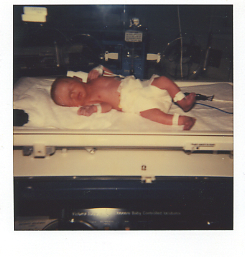Because a premature baby is early he/she is more prone to health problems. These tiny premature babies often have underdeveloped lungs as well as other issues and as a result have higher rates of disabilities such as cerebral palsy.
Because of the various health concerns a premature baby is given medical assistance immediately after delivery. Depending on how prematurely a baby arrives he/she is likely to be transferred to the neonatal intensive care unit (NICU), for assessment to determine his/her medical needs.

Below are some of the more common conditions that occur in premature babies:
Respiratory Distress Syndrome
a breathing disorder related to the baby’s immature lungs. Because a premature baby’s lungs frequently lack surfactant, a liquid substance that allows the lungs to remain expanded. Artificial surfactants are often used to treat these tiny babies in conjunction with a ventilator to improve baby’s breathing and to help maintain sufficient oxygen levels in the blood.
Bronchopulmonary Dysplasia
is the medical term used to describe babies who require oxygen over a longer period of time. The severity of this condition varies and as baby’s lungs mature they tend to outgrow the condition.
Apnoea
is the medical term given when the regular breathing rhythm is interrupted for more than fifteen seconds. The condition is often is associated with a reduced heart rate, known medically as bradycardia. A pulse oximeter is used to measure oxygen saturation a drop in oxygen is known as de-saturation. The majority of babies outgrow the condition by the time they go home.
Retinopathy of prematurity (ROP)
previously known as retrolental fibroplasia (RLF), is an eye disease that affects premature babies in which the retina is not fully developed. The majority of cases resolve without the need for treatment, although serious cases may require surgery. Both oxygen toxicity and relative hypoxia can contribute to the development of ROP.
Jaundice
is the result ofabuild in the baby’s blood of achemical called Bilirubin. As a result of this build up the baby’s skin takes on a yellow tinge. Treating the condition involves placing the undressed baby under special lights whilst covering baby’s eyes to protect them from damage.
(ArticlesBase SC #4110371)
About the Author: Sue Edmondson runs Prem2Pram the on line premature baby store http://www.prem2pram.co.uk as a mother herself of two premature babies she understands the difficulties parents face when their baby arrives early.
